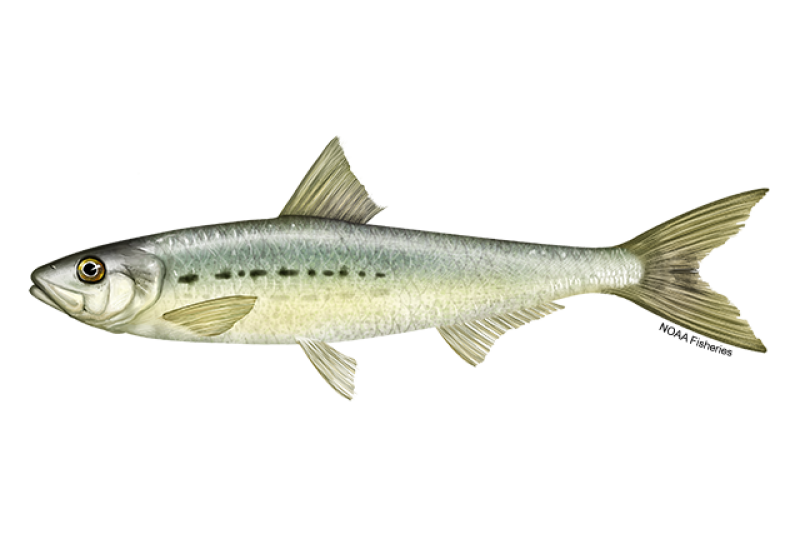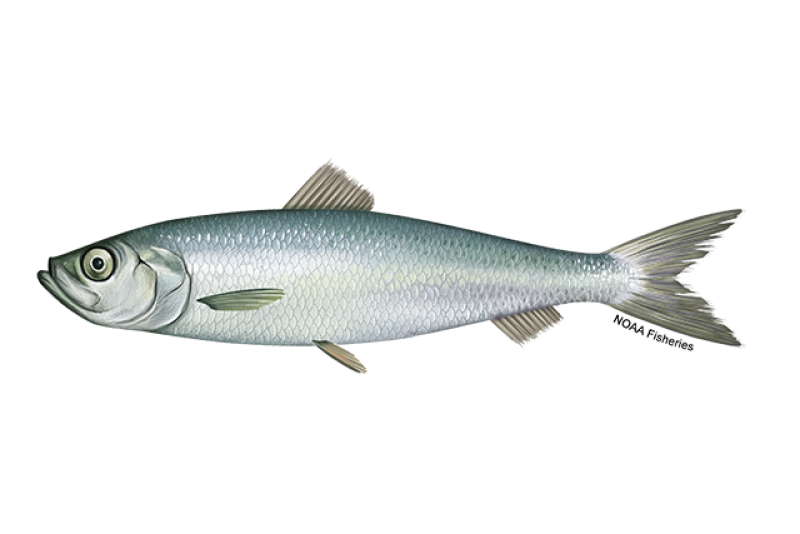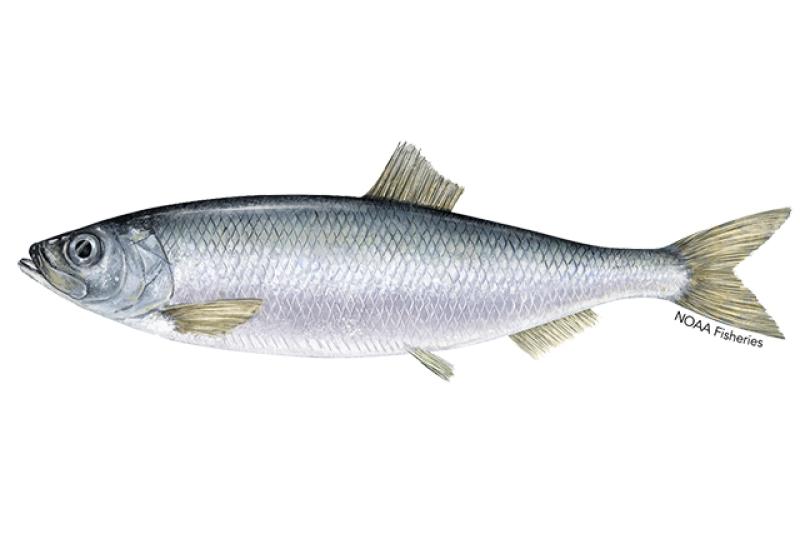 Pacific sardine. Credit: iStock
Pacific sardine. Credit: iStock
Pacific sardine. Credit: iStock
About the Species
 Pacific sardine. Credit: iStock
Pacific sardine. Credit: iStock
Pacific sardine. Credit: iStock
Commercial fishing for Pacific sardines is prohibited because the population is estimated to be below a precautionary level set by managers.

Population
The stock is overfished, but the fishing rate established under a rebuilding plan promotes population growth.

Fishing Rate
The fishery is closed, but the stock is not subject to overfishing.

Habitat Impact
The gear used to catch Pacific sardines is used at the surface and has little impact on habitat.

Bycatch
Bycatch is low because gear used is selective.
Population Status
- Pacific sardine is overfished (2025 stock assessment), and is not subject to overfishing based on 2023 catch data. Summary stock assessment information can be found on Stock SMART.
- The population size varies naturally, which can lead to large fluctuations (boom-bust cycles) in abundance and catch.
- A precautionary measure is built into sardine management to stop directed fishing when the population falls below 150,000 metric tons. The latest population estimate is below that level, and managers have closed the fishery.
Appearance
- Pacific sardines are small.
- They are blue-green on the back and have white flanks with one to three sets of dark spots along the middle.
Biology
- Pacific sardines are fast growing and can grow to more than 12 inches long.
- They can live up to 13 years, but usually not past 5.
- They reproduce at age 1 or 2, depending on conditions.
- Pacific sardines spawn multiple times per season.
- Females release eggs that are fertilized externally and hatch in about 3 days.
- Pacific sardines feed on plankton (tiny floating plants and animals).
- They are prey for many fish, marine mammals, and seabirds.
Where They Live
Range
- Southeastern Alaska to Baja California, Mexico.
Habitat
- Pacific sardines live in the water column in nearshore and offshore areas along the coast.
- They are sometimes found in estuaries.
- They form large, dense schools near the ocean surface.
- Pacific sardines move seasonally along the coast.
- Older adults may move from spawning grounds in southern California and northern Baja California to feeding/spawning grounds off the Pacific Northwest and Canada.
- Younger adults appear to migrate to feeding grounds primarily in central and northern California.
Fishery Management
- NOAA Fisheries and the Pacific Fishery Management Council manage the Pacific sardine fishery.
- Managed under the Coastal Pelagic Species Fishery Management Plan:
- Catch limits are in place to prevent overfishing.
- Catch limit is allocated among three fishing seasons throughout the year.
- Permits are needed to harvest Pacific sardines.
- Gear restrictions are in place to reduce bycatch.
- Catch is monitored through logbooks and observers.
- A rebuilding plan to rebuild the stock to the target population level is in place with a target date of 2035.
Harvest
- The fishery was closed in 2015, and has not reopened.
- In 2014, more than 23,000 metric tons were harvested and were valued at $8.85 million.
- Round haul nets are used to catch Pacific sardines.
- Habitat and bycatch impacts are minimal because the gear is used at the surface around dense schools of fish, which usually contain only one species.
Scientific Classification
- Southeastern Alaska to Baja California, Mexico.
- Pacific sardines live in the water column in nearshore and offshore areas along the coast.
- They are sometimes found in estuaries.
- They form large, dense schools near the ocean surface.
- Pacific sardines move seasonally along the coast.
- Older adults may move from spawning grounds in southern California and northern Baja California to feeding/spawning grounds off the Pacific Northwest and Canada.
- Younger adults appear to migrate to feeding grounds primarily in central and northern California.
Fishery Management
- NOAA Fisheries and the Pacific Fishery Management Council manage the Pacific sardine fishery.
- Managed under the Coastal Pelagic Species Fishery Management Plan:
- Catch limits are in place to prevent overfishing.
- Catch limit is allocated among three fishing seasons throughout the year.
- Permits are needed to harvest Pacific sardines.
- Gear restrictions are in place to reduce bycatch.
- Catch is monitored through logbooks and observers.
- A rebuilding plan to rebuild the stock to the target population level is in place with a target date of 2035.
Harvest
- The fishery was closed in 2015, and has not reopened.
- In 2014, more than 23,000 metric tons were harvested and were valued at $8.85 million.
- Round haul nets are used to catch Pacific sardines.
- Habitat and bycatch impacts are minimal because the gear is used at the surface around dense schools of fish, which usually contain only one species.
Scientific Classification
| Kingdom | Animalia | Phylum | Chordata | Class | Actinopterygii | Order | Clupeiformes | Family | Clupeidae | Genus | Sardinops | Species | sagax caerulea |
|---|
Last updated by NOAA Fisheries on 08/20/2025
Featured News
 The sunset glows as the ship pulls the MFT through calm waters. Photo Credit Greg Shaughnessy
The sunset glows as the ship pulls the MFT through calm waters. Photo Credit Greg Shaughnessy
 A school of Pacific sardines. Credit: NOAA Fisheries/Dale Sweetman
A school of Pacific sardines. Credit: NOAA Fisheries/Dale Sweetman
 Sardine collected on the 2023 Coastal Pelagic Species Survey. Pacific and Japanese sardine look so similar that they can only be distinguished by genetics. Genomic analysis later revealed that the catch contained both species. Photo Credit: NOAA Fisheries/Kelsey James
Sardine collected on the 2023 Coastal Pelagic Species Survey. Pacific and Japanese sardine look so similar that they can only be distinguished by genetics. Genomic analysis later revealed that the catch contained both species. Photo Credit: NOAA Fisheries/Kelsey James
Surprise! Japanese Sardines Astonish Scientists by Crossing the Pacific to the West Coast
 Juvenile coho salmon. Credit: iStock
Juvenile coho salmon. Credit: iStock
NOAA Fisheries Releases 2023 Status of Stocks
Seafood Facts

Are Pacific Sardines Sustainable?
Commercial fishing for Pacific sardines is prohibited because the population is estimated to be below a precautionary level set by managers.
Availability
Usually year-round, but currently unavailable because the fishery is closed.
Source
U.S. wild-caught from Washington to California.
Taste
When fresh, small sardines have a delicate flavor. Larger sardines have a fuller, oilier flavor, similar to anchovies but milder. If buying fresh, look for sardines with bright eyes, shiny skin, and a mildly fishy aroma. Plan to cook them within a day of purchase.
Texture
Firm when canned; soft when fresh.
Color
Pale red to off-white.
Health Benefits
Sardines are a very good source of selenium and vitamin B12 and a good source of calcium, niacin, phosphorus, and omega-3 fatty acids.
Nutrition Facts
Servings: 1; Serving Weight: 100 g; Calories: 217; Protein: 24.58 g; Total Fat: 12.37 g; Total Saturated Fatty Acids: 2.791 g; Carbohydrate: 0 g; Total Sugars: 0 g; Total Dietary Fiber: 0 g; Cholesterol: 82 mg; Selenium: 52.6 mcg; Sodium: 918 mgMore Information
Last updated by NOAA Fisheries on 08/20/2025
Seafood News
 Thomas Piecuch flips floating oyster bags on his farm (Credit: Holy Ground Oyster Company).
Thomas Piecuch flips floating oyster bags on his farm (Credit: Holy Ground Oyster Company).
Celebrating Aquaculture Week: Farming from Tide to Table
 NOAA team members adjust a prototyped turtle excluder device (TED) before sending it to divers below for continued testing on the NOAA R/V Caretta. Credit: NOAA Fisheries (ESA Permit 20339)
NOAA team members adjust a prototyped turtle excluder device (TED) before sending it to divers below for continued testing on the NOAA R/V Caretta. Credit: NOAA Fisheries (ESA Permit 20339)
Small Modifications to Turtle Excluder Devices Have Big Impacts for Gulf Sea Turtles
 Pacific oysters travel down a sorting tumbler at Salty Lady Seafood Company in Juneau, Alaska. Credit: Salty Lady Seafood Company.
Pacific oysters travel down a sorting tumbler at Salty Lady Seafood Company in Juneau, Alaska. Credit: Salty Lady Seafood Company.
 Commercial fishing boats lined up in Sitka, Alaska. Credit: Shutterstock.
Commercial fishing boats lined up in Sitka, Alaska. Credit: Shutterstock.
NOAA Fisheries Seeks Recommendations for Restoring American Seafood Competitiveness
Documents
Proceedings of the 22nd Annual Trinational Sardine & Small Pelagics Forum Virtual Event - May 2, 2022
Proceedings of the virtual 22nd Annual Trinational Sardine and Small Pelagics Forum (TSF), hosted…
Proceedings Of The 2021 Trinational Sardine & Small Pelagics Forum (PDF, 37 pages)
Proceedings of the virtual 21st Annual Trinational Sardine and Small Pelagics Forum (TSF), hosted…
Proceedings of the 2019 Trinational Sardine & Small Pelagics Forum
Proceedings of the 20th Annual Trinational Sardine and Small Pelagics Forum (TSF) held on December…
Assessment of the Pacific Sardine Resource in 2020 for U.S. Management IN 2020-2021
An assessment of the Pacific sardine resource in support of the Pacific Fishery Management Council …
Research
Southwest Fisheries Science Center Stock Assessments
Our stock assessments provide information on the dynamics of fish populations and scientific information to fishery managers regarding stock status, historical and future biomass, and recruitment trends.
Trinational Sardine and Small Pelagics Forum
The Trinational Sardine and Small Pelagics Forum comprises sectors of government, academia, and industry from Mexico, Canada, and the United States to collaborate in improving coast-wide stock assessments.
Fisheries Oceanography in the California Current
We contribute to the understanding of the effects of climate change and climate variability on pelagic fisheries, with a primary focus on the ecology of fishes living in the California Current Ecosystem and other forage species.
Experimental Aquarium at the Southwest Fisheries Science Center
The aquarium at the Southwest Fisheries Science Center facilitates research across many species, including the endangered black and white abalone.
Last updated by NOAA Fisheries on 08/20/2025



